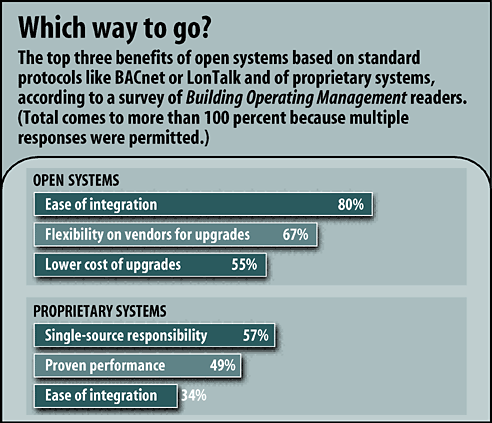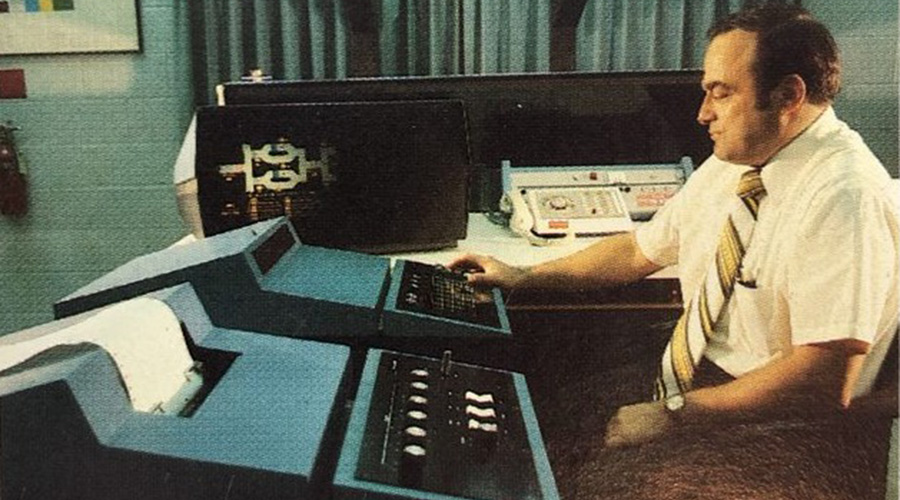Proprietary or Open? Real Question is, ‘What’s in it for Me?’
It sounds like a question about technology: How easy is it to implement an open system? But talk to facility executives and it doesn’t take long to realize that the question can’t be answered simply by looking at integrated systems technology.
Consider the points of view of a pair of seasoned facility executives. Both have a sophisticated understanding of open systems — and utterly different perspectives on that topic.
One of these facility executives has taken a close look at open systems based on standard protocols and is concerned about the need to develop extremely precise specifications. “Owners have to describe exactly what points they want to see,” he says. “In some cases, if you don’t do that, or you don’t communicate correctly with the designer, you can wind up with a big mess.”
Like many of his peers, this facility executive is concerned about minimizing the risk of problems. “Hardwired is the simplest,” he says. “It’s fail-safe and the easiest to diagnose. I have about 180 chillers and I need to minimize any diagnosis failure. The mechanic standing in front of the chiller has to be able to diagnose the problem with the tools he has.”
Facility executive No. 2 sees the question of implementing open systems very differently. “I haven’t found it to be all that difficult,” he says. His goal is simplicity, both for the present and the future. He has effectively standardized on a heat pump supplier and a controls vendor, both of which are represented by a single contractor. The heat pumps come from the factory with alarm and monitoring points already programmed. It takes a week or two to work out the bugs, he says, and during that time he makes sure he has a good programmer on hand. “It’s not quite as simple as plug and play,” he says. “But it’s sometimes close to that. The hardest part is configuring it the way you want, and that isn’t all that hard.”
So is it easy to implement open systems or not? That’s the wrong question to ask. As with so many issues connected with integration, technology has to take a back seat to other questions.
System integration isn’t primarily a matter of selecting the best hardware or software. The real question is which choice will produce the most benefits, given an organizations’ needs and capabilities.
Nowhere is that question more important than in the choice between open systems and proprietary systems. Those two choices promise very different benefits. And the choice made will have a major impact on what the system costs, what benefits it delivers and what complications arise.
Unfortunately, facility executives sometimes decide between open or a proprietary systems without a solid grasp of costs, benefits and potential pitfalls. One big reason is the level of marketing hype and sales pressure involved. But another issue is the failure to look closely enough at potential benefits to understand which ones the organization will actually achieve. Instead, decisions are based on assumptions. And when the assumptions are wrong, they can lead down a technology path of no return.
The question of the benefits and costs of open and proprietary systems is another example of the way that the process of integrating systems is fraught with misunderstandings. The first article in this series described the ways that Venus-and-Mars relationship between vendors and facility executives complicates the task of linking systems. The second article examined interoperability jargon that makes it harder to achieve the goal of integration. This article will take a hard look at the benefits of open and proprietary systems.
Weighing the Choices
Although interoperability and open systems get most of the fanfare in magazine articles and conference sessions, proprietary systems still hold the lion’s share of the market. One reason can be described as the comfort factor. “You know the system works, you know the company stands behind it, and you know the compatibility is there,” says a facility executive who, despite run-ins with proprietary vendors and concerns about cost, plans to stay with proprietary systems from large companies. “They can make it do what it’s supposed to do.”
What’s more, say vendors of proprietary systems, their offerings provide one-stop shopping for everything from the initial installation to ongoing service and upgrades. By contrast, with a multivendor open system, someone has to manage all the vendors. More work and expertise may be required to specify a multivendor open system. And if something goes wrong, it’s not always clear whose responsibility it is.
To top it off, on extensive integration projects, the facility executive could be locked in to the integrator, say proprietary vendors.
The big knock on proprietary systems is the cost of service and upgrades. That’s far and away the biggest reason facility executives want the ability to change vendors. But facility executives who choose open systems to get what proponents frequently call “freedom of choice” need to be clear about the benefits they expect from their choices.
On one level, “freedom of choice” means that a system can be designed with products from several vendors. In theory, that flexibility could enable facility executives to select what vendors sometimes call “best of breed” products — an automation system from vendor A, a fire safety system from vendor B and a security system from vendor C — rather than being limited to a proprietary vendor.
That’s an appealing strategy, but there are complications. Today, there are fewer open fire or security systems than there are HVAC and energy management systems. And it’s more complex to operate and maintain a multivendor system.
“How open do people really want to be?” asks one equipment manufacturer. “There’s a value to having a standard automatic temperature controller, for example. But customers want it to be less painful to divorce.”
An open system makes it easier to do that. “If I have a problem with a VAV box and it becomes an epidemic, I can go to another supplier,” says a facility executive moving to an interoperable system.
That’s not to say doesn’t mean switching vendors is easy. “My observation is that people don’t use open systems to switch suppliers,” says a vendor. “It’s a business issue, not a technology issue. The cost of exercising freedom of choice is pretty big.”
Even for facility executives who remain satisfied with their vendors, an open system provides a crucial benefit: cost control. At this end of the spectrum, “freedom of choice” amounts to a way of keeping vendors in line on service contracts and upgrades.
“With a proprietary system, there’s always the question of whether you’re getting the best price,” says one facility executive who has a proprietary system. “You have nothing to compare it to.”
Another facility executive who has experience with both open and proprietary systems estimates that service on a proprietary system is 35 percent higher than it would be if it were possible to get competitive bids. “LonMark and BACnet have given me the ability to get really good pricing,” he says.
Fortunately for facility executives, the choice need not come down to a proprietary, single-vendor system vs. an open, multiple-vendor option. Vendors that once offered only proprietary systems are moving toward open offerings. And some vendors that have open systems also have a wide range of products.
What’s more, a facility executive may be able to go with a proprietary system and still hold the line on costs.
One facility executive would prefer to stay with the proprietary vendor that provided and operates his energy management system. “These guys can do anything with it,” he says. But he is feeling pressure from the board of directors to get competitive bids on all projects.
As a result, he is looking at open-system options. But he’s also reviewing a novel approach: Getting an estimator to determine what the proprietary vendor should be charging and then negotiate the difference, pushing for big discounts on hardware.
Valuable Lesson
That facility executive’s plan highlights the extent to which benefits hinge on the specifics of individual organizations. His “competitive bidding” strategy could only be considered because he has the credibility to gain top-management buy-in on his approach — credibility that comes from a track record for cutting facility costs.
But the strategy also illustrates another important lesson about benefits and choices: As important as it is to design an integrated system around the needs and capabilities of an organization, it’s also worthwhile to remember that the organization itself can change. And those changes can create new opportunities for integrated systems.
“When I got here, the staff was dependent on vendor field service personnel — a little too dependent, I thought,” says one facility executive. That was eight years ago. Today, a better trained staff is capable of making some programming changes to an interoperable, multivendor system.
It’s not just operating staff that can limit system integration choices. One facility executive who uses proprietary systems admits he hasn’t really looked into open options. “There’s so much inertia,” he says. “You don’t have time to get out of the construction-production mode and do research.”
Organizational change is never easy, whether it’s ramping up the skills of the operating staff or restructuring management responsibilities to make it a priority to keep up with technology options. Is it worth the effort? That depends on the benefits of change. Ongoing cost pressures likely will make it harder and harder not to at least consider whether an open system is a good investment.
“If you’re comfortable paying extra, just stay with proprietary systems,” says one facility executive who is a proponent of open systems. “But as a large organization we can’t afford to make that kind of excuse any more.”

Does an Open System Cost More up Front?
It’s one thing to demonstrate the life-cycle cost advantages of one building system over another; it’s another to win approval to pay more up front to get that system.
Many facility executives believe they face that dilemma with integrated systems: Even though proprietary systems will cost more in the long term, many facility executives believe that they’ll pay more to install an open system than a proprietary system. But a closer look reveals the first-cost issue isn’t black and white.
For facility executives, there certainly is an internal cost involved in the move to open systems. Facility executives need a fairly sophisticated understanding of both terms and technology to assure that an open system has the functions they need and is as open as they want it to be. And mastering the complexity involved requires an investment of staff time — an investment that can be difficult for some hard-pressed facility organizations to make.
When it comes to the out-of-pocket costs, however, some industry observers see no reason why open systems should cost more than proprietary systems. On one major project, the building owner — a state government — worked with a vendor to develop what was supposed to be an open-system specification. As it turned out, however, only the vendor that had developed the specification could meet it.
The owner then turned to an independent system integrator for a new specification on the next phase of the project. Most bids came in right around what the state had budgeted — except for a much lower bid from the system integrator that had specified the project. Once again, it seemed that a specification had been written so that only one firm could meet it.
But the next phase of the project was a different story. Competitive vendors sharpened their pencils and came in with lower bids. The result? “We lost the second phase by less than one half percent,” says the system integrator.
That system integrator sees no reason an open system should cost more. “I’ve heard that argument plenty of times but I’m not seeing it reflected in the prices of products,” he says. “It doesn’t hold water in the marketplace.”
Another project involved a government organization planning a new building. The owner decided not to require that the new facility be linked to an open-system network connecting buildings around the state; the concern was that an open system would cost more. But the low bidder was a vendor proposing an open system based on a standard protocol.
“There really is no cost impact,” says an industry observer familiar with that project. The price will depend on local market conditions, not whether the system is based on a standard protocol.
Is an open system more expensive for a vendor? Even if hardware costs are no higher, a vendor moving from a proprietary system to an open system will have to cover the costs of training staff and developing new tools.
“Integration companies have to learn a whole new way of doing business,” says one vendor. “Over time, the cost of system integration should go down. But I’m not sure it’s happening yet. The industry is still learning.”
Of course, vendors don’t set prices in a vacuum. They have to decide what types of projects they’re going to target and then try to be competitive on those projects, even if margins are squeezed. For example, vendors of proprietary systems will sometimes use the initial installation as a loss leader so they can secure years of upgrade and service contracts — business so lucrative it more than makes up for money lost on the initial installation. On the other hand, the perception that open systems should cost more can become a self-fulfilling prophecy, giving a vendor a rationale for raising its bid on the initial installation.
— Edward Sullivan
The first article in this series, “Systems Integration: Getting from Good to Best No Easy Task,” appeared in the August issue of Building Operating Management. The second, “With Systems Integration, Words Can Get in the Way,” appeared in September.
Sources
Mark Behar, Brian Stowell Alerton • Jay Pitcher Althoff Industries • Steve Gavlek American Auto-Matrix • Rick Focke, Don Lemenanger, Jon Williamson, Rainer Wischinski Andover • Steve Tom Automated Logic • Ron Caffrey BCS Partners • Jonathan Fulton Building Control Integrators • Kirk McElwain CABA • Mark Tozzi Carrier • James Lee Cimetrics • Mike DeNamur Comfort Systems • Brian Crimmins Crozer Keystone Health System • Raymond Rae, Brian Dutt Delta • Steve Nguyen Echelon • Jim Shulkin Essention • Marty Emmick, Bill True Fidelity • Stephen Ferree FieldServer Technologies • Sanjiv Bhaskar Frost & Sullivan • Dean McCauley, Steve White GSA • Robert de Grasse Grubb & Ellis • Tom Gormley, Byron Hall HCA • John Hatcher HMA Consulting • David Robinson, Thomas Bay Hines • Simon James Honeywell • Ralph Box, David Gill, Kevin Strohman Invensys • Terry Hoffman Johnson Controls • Thomas Plating Jones Lang LaSalle • Don King Kaiser Permanente • Barry Haaser, Jeremy Roberts LonMark Interoperability Association • Jonathan Buckley McData • Mark Bergman McQuay • Lenny Jachimowicz Marriott • Steven Bushby NIST • Ron Sharpe The Ohio State University • Jim Damico Osceola District Schools • Jay Hendrix, Christopher Hollinger Siemens • Mark Rehwald Staefa • Dean Meyer TAC • Pat Jastroch T. Wall Properties Management • Roger Schenck Technical Solutions & Services • Charles Beach Team Engineering • Andy McMillen Teletrol • Jay Althof, Randy Amborn Trane • Dennis Tuft Tridium • Carl Ruther University of Cincinnati • Victor Atherton University of Miami • John Vucci University of Maryland • Kurtis Johnson University of Wisconsin • Hank Marier Wells Fargo • Jack Gornik York
Related Topics:












